Carboxylic Acids
In this article we will cover the following learning outcomes in the topic of Carboxylic Acids:
- Describe carboxylic acids as a homologous series containing the \(\small \mathsf{-COOH}\) group.
- Name and draw the structures of the first four carboxylic acids.
- Describe the reactions of carboxylic acids with reactive metals, carbonates and bases.
- Describe the formation of esters from the reaction of carboxylic acids with alcohols.
Introduction of Carboxylic Acids
Carboxylic acids are a homologous series of organic acids which have the carboxyl \(\small \mathsf{(- COOH \,)}\) functional group.

acetic acid
Carboxylic acids are not hydrocarbons, as they contain oxygen atoms in their molecules. Hydrocarbons are organic compounds that contain hydrogen and carbon atoms only.
The general formula of carboxylic acids: \(\small \mathsf{C_nH_{2n+1}COOH}\) where \(\small \mathsf{n = 0, 1,2,3,}\) etc.
Let us consider when \(\small \mathsf{n = 0}\),
Substituting this value into the general formula of carboxylic acid, we get
\(\begin{align*} \small \mathsf{C_nH_{2n+1}COOH} &= \small \mathsf{C_0H_{2(0)+1}COOH} \\[2ex] &= \small \mathsf{HCOOH} \end{align*}\)
Hence, the first member in the carboxylic acid homologous series has the molecular formula \(\small \mathsf{HCOOH}\).
Let’s get to know the Carboxylic Acids!
When naming the carboxylic acids, the prefix tells us the number of carbon atoms in the molecule and the suffix tells us the homologous series the molecule belongs to. The homologous series here is carboxylic acid, hence, the suffix is ‘-oic acid’.
The table below shows the names and formulae of the first four carboxylic acids.
| Number Of Carbon Atoms | Name Of Carboxylic Acid | Molecular Formula |
|---|---|---|
| 1 | methanoic acid | \(\small \mathsf{HCOOH}\) |
| 2 | ethanoic acid | \(\small \mathsf{CH_3COOH}\) |
| 3 | propanoic acid | \(\small \mathsf{C_2H_5COOH}\) |
| 4 | butanoic acid | \(\small \mathsf{C_3H_7COOH}\) |
Observe the molecular formulae of the first four alcohols in the series. Each member of the alcohol homologous series differs from the next by a \(\small \mathsf{- \;CH_2\; -}\) unit.
Structural formula of Carboxylic Acids
A structural formula shows how atoms are arranged in a molecule. It also shows the bonds between the atoms in a molecule.
The table below shows the structural formulae of the first four carboxylic acids in the homologous series.

Note: The structural formula can also be displayed in a condensed manner. For instance, the condensed formula of propanoic acid can be written as \(\small \mathsf{CH_3CH_2COOH}\). The condensed formula of butanoic acid can be written as \(\small \mathsf{CH_3CH_2CH_2COOH}\).
Question 1:
The structures of an acid and an alcohol are shown below.
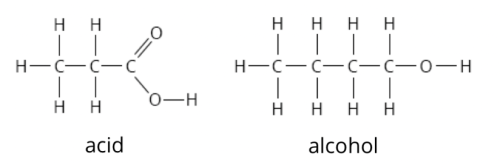
Which pairing of names correctly identifies the two compounds?

Solution:
(4) propanoic acid propanol
Explanation:
The carboxylic acid molecule contains 3 carbon atoms. The prefix for 3 carbon atoms is “prop-”.
The alcohol molecule contains 4 carbon atoms. The prefix for 4 carbon atoms is “but-”.
Carboxylic Acids as weak acids
Carboxylic acids are weak acids because they ionise partially in aqueous solution, to produce a low concentration of hydrogen ions. They have a pH value of about 3 to 4.
Take the ionisation of ethanoic acid for instance:
\(\small \textsf{ethanoic acid} \rightleftharpoons \textsf{ethanoate ion + hydrogen ion} \)
\(\small \mathsf{CH_3COOH \,(aq)} \rightleftharpoons \mathsf{CH_3COO^-\,(aq) + H^+\,(aq)}\)

Chemical properties of Carboxylic Acids
The hydrogen ions give the carboxylic acids their acidic properties.
Reaction with Reactive Metals
Carboxylic acids react with reactive metals to produce a salt and hydrogen gas.
\(\small \textsf{carboxylic acid + metals} \xrightarrow{\quad}{} \textsf{salt + hydrogen}\)
For Example:
Ethanoic acid reacts with sodium metal to produce sodium ethanoate and hydrogen.
\(\small \textsf{ethanoic acid + sodium} \xrightarrow{\quad} \textsf{sodium ethanoate + hydrogen}\)
\(\small \mathsf{2CH_3COOH + 2Na} \xrightarrow{\quad} \mathsf{2CH_3COONa + H_2}\)
Reaction with Carbonates
Carboxylic acids react with carbonates to produce salt, carbon dioxide, and water.
\(\small{\textsf{carboxylic acid + carbonate} \xrightarrow{\quad} \textsf{salt + carbon dioxide + water}}\)
For Example:
Ethanoic acid reacts with magnesium carbonate to produce magnesium ethanoate, carbon dioxide, and water.

Reaction with bases
Carboxylic acids react with bases to produce salt and water.
\(\textsf{carboxylic acid + bases} \quad\xrightarrow\qquad\quad \textsf{salt + water}\)
For Example:
Ethanoic acid reacts with sodium hydroxide to produce sodium ethanoate and water.

Note that for the formation of salt from carboxylic acid, the metal is generally written after the acid in the chemical formula of the salt.
Question 2:
The results of tests on compound Z are shown below.
| Test | Observation |
|---|---|
| add bromine water | turn colourless |
| add aqueous sodium carbonate | effervescence is observed |
What is compound Z?

Solution:
(4) \(\small \mathsf{CH_2CHCOOH}\)
Explanation:
Compound \(\small \mathsf{Z}\) decolourises bromine water, indicating that it contains at least a \(\small \mathsf{C=C}\) double bond. Alkenes with the \(\small \mathsf{C=C}\) double bond can undergo an addition reaction with bromine under normal conditions.
A reaction of compound \(\small \mathsf{Z}\) with sodium carbonate indicates that the carboxyl \(\small \mathsf{(-COOH)}\) group is present. Carboxylic acids are weak acids, hence they can react with carbonates to give salt, carbon dioxide, and water.
Question 3:
Which of the following ways can be used to distinguish between dilute ethanoic acid and ethanol?
- adding sodium carbonate
- adding water
- checking electrical conductivity
- using blue litmus paper
Options:
- IV only
- I and IV only
- I, III and IV only
- II, III and IV only
Solution:
(C) I, III and IV only
Explanation:
Ethanoic acid is acidic while ethanol is neutral. Thus, I and IV can be used as tests for acidity.
Ethanoic acid reacts with sodium carbonate to produce sodium ethanoate, water, and carbon dioxide. However, ethanol does not react with sodium carbonate.
Ethanoic acid will turn blue litmus paper red, but ethanol will not cause any change to the blue litmus paper.
In addition, dilute ethanoic acid can conduct electricity due to the presence of hydrogen ions, while dilute ethanol cannot conduct electricity.
Chemical properties of Carboxylic Acids
Reaction with Alcohols
When a carboxylic acid is warmed with an alcohol in the presence of a few drops of concentrated sulfuric acid, water and an ester are formed. This reaction is known as esterification.
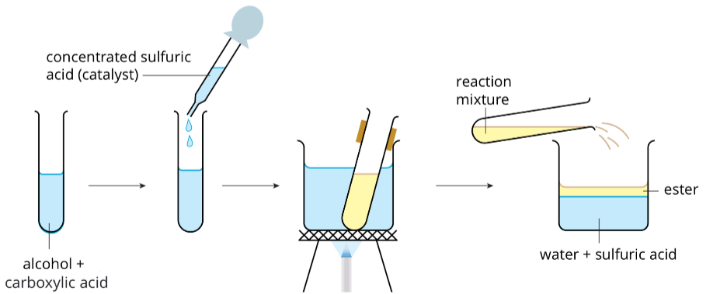
Ester is a sweet-smelling compound and a colourless liquid that is insoluble in water.
Esterification
When ethanol is warmed with ethanoic acid in the presence of a few drops of concentrated sulfuric acid, ethyl ethanoate which is an ester, and water are produced.
\( \small \textsf{ethanoic acid + ethanol} \rightleftharpoons \textsf{ethyl ethanoate + water}\)
\(\small \mathsf{CH_3COOH(aq) + C_2H_5OH(aq)} \rightleftharpoons \mathsf{CH_3COOC_2H_5(aq) + H_2O(l)} \)

Drawing of the structural formula of an Ester:
- Place the functional groups of the carboxylic acid and alcohol facing each other.
- Remove the \(\small \mathsf{-\,OH}\) group from the carboxylic acid and \(\small \mathsf{-\,H}\) group from the alcohol.
- Join both ends of the structures together to obtain the structural formula of the ester.
The functional group in an ester is the \(\small \mathsf{-\,COO}\) ester linkage.
Naming Esters
The name of an ester consists of 2 parts:

\(\begin{align*} \textsf{Ethanol} \quad&\xrightarrow \qquad\quad \textsf{ethyl} \\[2ex] \textsf{Ethanoic acid} \quad&\xrightarrow\qquad\quad \textsf{ethanoate} \end{align*}\)
Example 1:
Let us try naming the ester shown below.
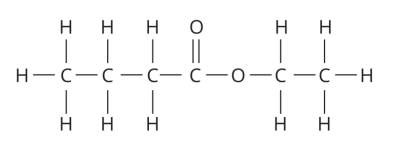
Solution :
Split the ester linkage halfway. The side with the \(\mathrm{-C=O}\) is from the carboxylic acid, while the side with the \(\mathrm{-O}\) is from the alcohol
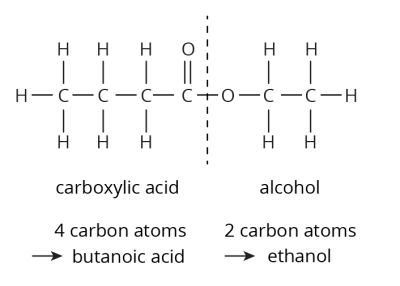
After identifying the carboxylic acid and the alcohol, we replace the ‘anol’ in the alcohol with ‘-yl’ and replace the ‘ic acid’ in the carboxylic acid with ‘ate’.
\(\begin{align*} \textsf{Ethanol} \quad&\xrightarrow \qquad\quad \textsf{ethyl} \\[3ex] \textsf{Butanoic acid} \quad&\xrightarrow\qquad\quad \textsf{butanoate} \end{align*}\)
The name of the ester is ethyl butanoate.
Question 5:
Look at the structural formula below.
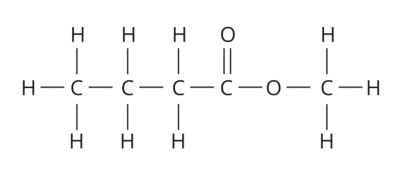
What is the name of the ester shown?
- propyl methanoate
- methyl butanoate
- methyl propanoate
Solution:
(B) methyl butanoate
Explanation:
Split the ester linkage halfway.
The alcohol used contains only 1 carbon atom, hence it is methanol.
The carboxylic acid used contains 4 carbon atoms, hence it is butanoic acid.
Replace the ‘anol’ in the alcohol with ‘-ly’ and replace the ‘ic acid’ in the carboxylic acid with ‘ate’
\(\begin{align*} \textsf{Methanol} \quad&\xrightarrow\qquad\quad \textsf{methyl} \\[3ex] \textsf{Butanoic acid} \quad&\xrightarrow\qquad\quad \textsf{butanoate} \end{align*}\)
Question 6:
Look at the structural formula below.
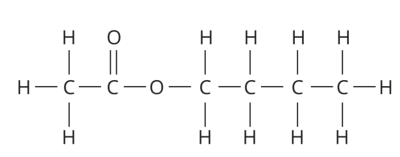
What is the name of the ester shown?
- butyl ethanoate
- ethyl butanoate
- butyl methanoate
Solution:
(A) butyl ethanoate
Explanation:
Split the ester linkage halfway.
The alcohol used contains 4 carbon atoms, hence it is butanol.
The carboxylic acid used contains 2 carbon atoms, hence it is ethanoic acid.
Replace the ‘anol’ in the alcohol with ‘-ly’ and replace the ‘ic acid’ in the carboxylic acid with ‘ate’
\(\begin{align*} \textsf{Butanol} \quad&\xrightarrow \qquad\quad \textsf{butyl} \\[2ex] \textsf{Ethanoic acid} \quad&\xrightarrow\qquad\quad \textsf{ethanoate} \end{align*}\)
Uses of Esters
- Esters are used in food and drinks as an artificial flavouring.
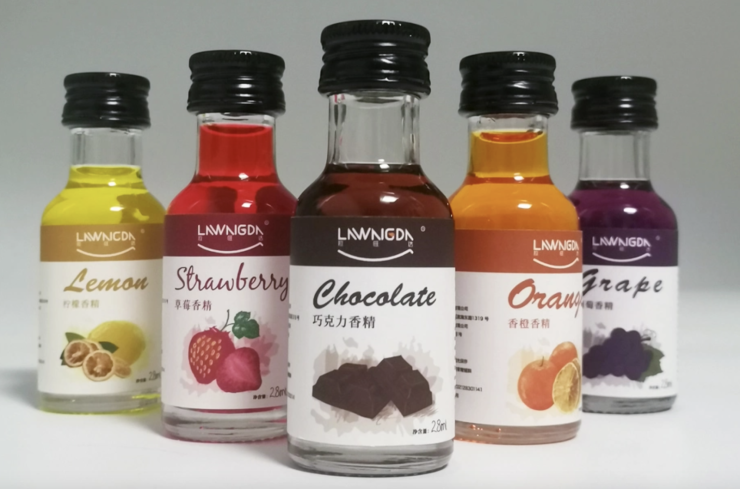
Image Credit: Baking Essence for Cake Biscuit Flavouring - Shangxiang Biotech
- Esters are also used as solvents for cosmetics, perfumes, and nail polishes.

Image Credit: Laura Chouette - unsplash.com
| Continue Learning | |
|---|---|
| Metals | Introduction to Organic Chemistry |
| Alcohols | Speed of Reaction |
| Electrolysis | Energy Changes |
| Ammonia | Alkanes |
| Alkenes | Carboxylic Acids |


 SG
SG  VN
VN 
















